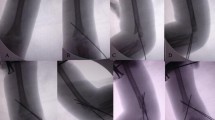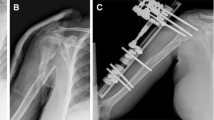Abstract
Introduction
Our goal in this study was to propose an alternative closed reduction method to avoid open reduction in the management of pediatric supracondylar humerus fractures. A temporary Kirschner wire is inserted to the proximal part of the humerus to be used as a joystick to have a better control of the proximal fragment.
Patients
Twenty-three patients with closed Gartland type III extension fractures were operated between 2003 and 2007. Mean age of the patients was 6.7 (4–10) years.
Method
Uninjured and fractured elbow’s Bauman angles, lateral condylar angles, the carrying angles and ROM values were compared statistically according to independent samples t test.
Results
At a mean follow-up 96.73 weeks (53–150), clinical results using the Flynn criteria were excellent in 21 (91.3%), good in 1(4.35%), fair in 1 (4.35%) patient.
Conclusion
These results suggest that the “joystick” reduction method is a reliable alternative when closed reduction itself is not successful.




Similar content being viewed by others
References
Chen RS, Liu DB, Lin XS, Feng XM, Zhu JM, Ye FQ (2001) Supracondylar extension fracture of the humerus in children. J Bone Joint Surg (Br) 83:883–887
Shim JS, Lee YS (2002) Treatment of completely displaced supracondylar fractures of the humerus in children by cross-fixation with three Kirschner wires. J Pediatr Orthop 22:12–16
Skagg DL, Hale JM, Bassett J et al (2001) Operative treatment of supracondylar fractures of the humerus in children. J Bone Joint Surg (Am) 83-A:735–740
Arabella L, Frrisancho J, Ebramzadeh E (2002) Delayed treatment of type 3 supracondylar humerus fractures in children. J Pediatr Orthop 22:203–207
Mehlman CT, Strub WM, Roy DR, Wall EJ, Crawford AH (2001) The effect of surgical timing on the perioperative complications of treatment of supracondylar humeral fractures in children. J Bone Joint Surg (Am) 83-A:323–327
O’Hara LJ, Barlow JW, Clarke NMP (2000) Displaced supracondylar fractures of the humerus in children. J Bone Joint Surg (Br) 82-B:204–210
Stevens SL, Mahar AT, Miesen D et al (2002) Displaced pediatric supracondylar humerus fractures: biomechanical analysis of percutaneous pining techniques. J Pediatr Orthop 22:440–443
Camp J, Ishizue K, Gomez M et al (1993) Alteration of Bauman’s angle by humeral position: implications for treatment of supracondylar humerus fractures. J Pediatr Orthop 13:521–525, 707
Archibald DAA, Roberts JA, Smith MGH (1991) Transarticular fixation for severely displaced supracondylar fractures in children. J Bone Joint Surg (Br) 73:147–149
Kekomaki M, Luoma R, Rikalainen H, Vilkki P (1984) Operative reduction and fixation of a difficult supracondylar extension fracture of the humerus. J Pediatr Orthop 4:13–15
Weiland AJ, Meyer S, Tolo VT, Bert HJL, Mueller J (1978) Surgical treatment of displaced supracondylar fractures of the humerus in children: analysis of fifty-two cases followed for 5–15 years. J Bone Joint Surg (Am) 60:657–661
Reitman RD, Waters P, Millis M (2001) Open reduction and internal fixation for supracondylar humerus fractures in children. J Pediatr Orthop 21:157–161
Cramer KE, Devito DP, Green NE (1992) Comparison of closed reduction and percutaneous pinning versus open reduction and percutaneous pinning in displaced supracondylar fractures of the humerus in children. J Orthop Trauma 6:407–412
Danielsson L, Pettersson H (1980) Open reduction and pin fixation of severely displaced supracondylar fractures of the humerus in children. Acta Orthop Scand 51:249–255
Mehlman CT, Crawford AH, McMillion TL, Roy DR (1996) Operative treatment of supracondylar fractures of the humerus in children: the Cincinnati experience. Acta Orthop Belg 62(suppl 1):41–50
Walloe A, Egund N, E”ikelund L (1985) Supracondylar fracture of the humerus in children: review of closed and open reduction leading to a proposal for treatment. Injury 16:296–299
Ozkoc G, Gonc U, Kayaalp A, Teker K, Peker TT (2004) Displaced supracondylar humeral fractures in children: open reduction vs. closed reduction and pinning. Arch Orthop Trauma Surg 124–128:547–551
Mohammad S, Rymaszewski LA, Runciman J (1999) The Baumann angle in supracondylar fractures of the distal humerus in children. J Pediatr Orthop 19:65–69
Flynn JC, Mathews JG, Benoit RL (1974) Blind pinning of displaced supracondylar fractures of the humerus in children: sixteen years’ experience with long-term follow-up. J Bone Joint Surg (Am) 56-A:263–272
Labelle H, Bunnell WP, Duhaime M, Poitras B (1982) Cubitus varus deformity following supracondylar fractures of the humerus in children. J Pediatr Orthop 2:539–546
Kurer MHJ, Regan MW (1990) Completely displaced supracondylar fracture of the humerus in children. Clin Orthop 256:205–214
Kallio PE, Foster BK, Paterson DC (1992) Difficult supracondylar elbow fractures in children: analysis of percutaneous pinning technique. J Pediatr Orthop 12:11–15
Cheng JC, Lam TP, Shen WY (1995) Closed reduction and percutaneous pinning for type III displaced supracondylar fractures of the humerus in children. J Orthop Trauma 9:511–515
Yu S-W, Su J-Y, Kao F-C, Ma C-H, Yen C-Y, Tu Y-K (2004) The use of the 3-mm K-wire to supplement reduction of humeral supracondylar fractures in children. J Trauma 57(5):1038–1042
Lee HY, Kim SJ (2007) Treatment of displaced supracondylar fractures of the humerus in children by a pin leverage technique. J Bone Joint Surg (Br) 89-B(5):646–650
Kasser JR (1992) Percutaneous pinning of supracondylar fractures of the humerus. Instr Course Lect 41:385–390
Boyd DW, Aronson DD (1992) Supracondylar fractures of the humerus: a prospective study of percutaneous pinning. J Pediatr Orthop 12:789–794
Rang M (1974) Children’s fractures. Lippincott, Philadelphia, p 101
Schoenecker PL, Delgado E, Rotman M, Sicard GA, Capelli AM (1996) Pulseless arm in association with totally displaced supracondylar fracture. J Orthop Trauma 10:410–415
Garbuz DS, Leitch K, Wright JG (1996) The treatment of supracondylar fractures in children with an absent radial pulse. J Pediatr Orthop 16:594–596
Fowles JV, Kassab MT (1974) Displaced supracondylar fractures of the elbow in children. A report on the fixation of extension and flexion fractures by two lateral percutaneous pins. J Bone Joint Surg (Br) 56:490–500
Zionts LE, McKellop HA, Hathaway R (1994) Torsional strength of pin configurations used to fix supracondylar fractures of the humerus in children. J Bone Joint Surg (Am) 76:253–256
Topping RE, Blanco JS, Davis TJ (1995) Clinical evaluation of crossed-pin versus lateral-pin fixation in displaced supracondylar humerus fractures. J Pediatr Orthop 15:435–439
Ikram MA (1996) Ulnar nerve palsy: a complication following percutaneous fixation of supracondylar fractures of the humerus in children. Injury 27:303–305
Pirone AM, Graham HK, Krajbich JI (1988) Management of displaced extension type supracondylar fractures of the humerus in children. J Bone Joint Surg (Am) 70:641–650
Brown IC, Zinar DM (1995) Traumatic and iatrogenic neurological complications after supracondylar humerus fractures in children. J Pediatr Orthop 15:440–443
Lyons J, Ashley E, Hoffer MM (1998) Ulnar nerve palsies after percutaneous crosspinning of supracondylar fractures in children’s elbows. J Pediatr Orthop 18:43–45
Royce RO, Dutkowsky JP, Kasser JR, Rand FR (1991) Neurologic complications after K-wire fixation of supracondylar humerus fractures in children. J Pediatr Orthop 11:191–194
Acknowledgments
None of the authors received payments or other benefits or a commitment or agreement to provide such benefits from a commercial entity. No commercial entity paid or directed, or agreed to pay or direct, any benefits to any research fund, foundation, educational institution, or other charitable or nonprofit organization with which the authors are affiliated or associated. This study has been reviewed by appropriate ethics committee and has therefore been performed in accordance with the ethical standards laid down in an appropriate version of the 1964 Declaration of Helsinki. All persons gave their informed consent prior to their inclusion in the study.
Author information
Authors and Affiliations
Corresponding author
Additional information
Level of evidence: level III study.
Rights and permissions
About this article
Cite this article
Parmaksizoglu, A.S., Ozkaya, U., Bilgili, F. et al. Closed reduction of the pediatric supracondylar humerus fractures: the “joystick” method. Arch Orthop Trauma Surg 129, 1225–1231 (2009). https://doi.org/10.1007/s00402-008-0790-8
Received:
Published:
Issue Date:
DOI: https://doi.org/10.1007/s00402-008-0790-8




